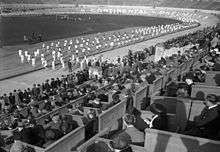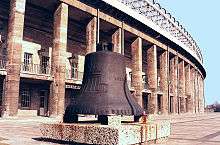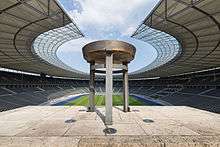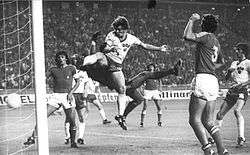Olympiastadion (Berlin)
 | |
|
| |
| Full name | Olympiastadion Berlin |
|---|---|
| Former names | Deutsches Stadion |
| Location | Westend, Charlottenburg-Wilmersdorf, Berlin, Germany |
| Coordinates | 52°30′53″N 13°14′22″E / 52.51472°N 13.23944°ECoordinates: 52°30′53″N 13°14′22″E / 52.51472°N 13.23944°E |
| Public transit |
Olympia-Stadion Olympiastadion |
| Owner | Olympiastadion Berlin GmbH |
| Operator | WALTER BAU-AG/DYWIDAG |
| Capacity | 74,475 [1] |
| Field size | 105 × 68 m |
| Surface | Grass |
| Construction | |
| Built | 1934 to 1936 |
| Opened | 1 August 1936[2] |
| Renovated |
1974 (Reconfiguration) 2000-2004 (World Cup) |
| Construction cost |
43 million RM (1936) €297 million (2016) |
| Architect |
Werner March/Albert Speer (1936) Friedrich Wilhelm Krahe (1974) |
| Tenants | |
|
Hertha BSC (1963–present) German national football team (Selected matches) | |
The Olympiastadion Berlin (German pronunciation: [ʔoˈlʏmpi̯aːˌʃtaːdi̯ɔn]) is a sports stadium in Berlin, Germany. It was originally built for the 1936 Summer Olympics by Werner March. During the Olympics, the record attendance was thought to be over 100,000. Today the stadium is part of the Olympiapark Berlin.
Since renovations in 2004, the Olympiastadion has a permanent capacity of 74,475 seats and is the largest stadium in Germany for international football matches. Olympiastadion is a UEFA category four stadium and one of the world's most prestigious venues for sporting and entertainment events.
Besides its use as an athletics stadium, the arena has built a footballing tradition. Since 1963, it has been the home ground of the Hertha BSC football team. It hosted three matches in the 1974 FIFA World Cup. It was renovated for the 2006 FIFA World Cup, when it hosted six matches, including the final. The German Cup (DFB-Pokal) final match is held each year at the venue. The Olympiastadion Berlin served as a host for the 2011 FIFA Women's World Cup as well as the 2015 UEFA Champions League Final.
History
1916–1934: Deutsches Stadion

During the 1912 Summer Olympics, the city of Berlin was designated by the International Olympic Committee (IOC) to host the 1916 Summer Olympics. Germany's proposed stadium for this event was to be located in Charlottenburg, in the Grunewald Forest, to the west of Berlin—thus the stadium was also known as Grunewaldstadion. A horse racing-course already existed there which belonged to the Berliner Rennverein, and even today the old ticket booths survive on Jesse-Owens-Allee. The government of Germany decided not to build in the nearby Grunewald forest, or to renovate buildings that already existed. Because of this desire, they hired the same architect who originally had built the "Rennverein", Otto March.
March decided to bury the stadium in the ground ("Erdstadion", in German). However, the 1916 Olympic Games were cancelled due to World War I. In the 1920s the first buildings of a school, the "Deutsches Sportforum" (German Sport Forum), dedicated to the teaching of professors of physical education and the study of sport science were built northeast of the stadium site. From 1926 to 1929, Otto March's sons (Werner and Walter) were assigned to build an annex for these institutions, though the finalization was delayed until 1936.
1936–1945: Olympiastadion
.jpg)
In 1931, the International Olympic Committee made Berlin the host city of the 11th Summer Olympics. Originally, the German government decided merely to restore the earlier Olympiastadion (Olympic Stadium) of 1916, with Werner March again retained to do this.
When the Nazis came to power in Germany (1933), they decided to use the Olympic Games in 1936 for propaganda purposes. With these plans in mind, Adolf Hitler ordered the construction of a great sports complex in Grunewald named the "Reichssportfeld" with a totally new Olympiastadion. Architect Werner March remained in charge of the project, assisted by his brother Walter.
Construction took place from 1934 to 1936. When the Reichssportfeld was finished, it was 1.32 square kilometres (326 acres). It consisted of (east to west): the Olympiastadion, the Maifeld (Mayfield, capacity of 50,000) and the Waldbühne amphitheater (capacity of 25,000), in addition to various places, buildings and facilities for different sports (such as football, swimming, equestrian events, and field hockey) in the northern part.
Werner March built the new Olympiastadion on the foundation of the original Deutsches Stadion, once again with the lower half of the structure recessed 12 meters below ground level.
The capacity of the Olympiastadion reached 110,000 spectators. It also possessed a special stand for Adolf Hitler and his political associates. At its end, aligned with the symmetrically-designed layout of the buildings of the Olympischer Platz and toward the Maifeld, was the Marathon Gate with a big receptacle for the Olympic Flame.
To the east of the stadium, there were two field hockey stadia that hosted the competitions that were won by India.
Maifeld
The Maifeld (Mayfield) was created as a huge lawn (112,000 square metres, 28 acres) for gymnastic demonstrations, specifically annual May Day celebrations by the government. The area was surrounded by 19 metres of land elevation (62 ft), even though the Olympiastadion (to the east) was only 17 metres (55 ft) high. The total capacity was 250,000 people, with 60,000 in the large stands that extended at the west end.
Also located there were the Langemarck-Halle (below) and the Bell Tower (rising high). The walls were built with sturdy stone from the area of the Lower Alps, and also feature equine sculptures (work of Josef Wackerle). This consisted of huge halls built under the stands of the Maifeld. Pillars were raised on which hung flags and shields commemorating all the forces that participated in a battle fought in Langemark (West Flanders, Belgium) on 10 November 1914, during the First World War. Since 2006, the ground floor is home to a public exhibit providing historical information on the area of the former Reichssportfeld.
During the 1936 Olympics, the Maifeld was used for polo and equestrian dressage events.
After World War II the British military occupation forces (Berlin Infantry Brigade) annually celebrated the Queen's Official Birthday on the Maifeld and used it for a variety of sporting activities including cricket. Starting in 2012, Maifeld became home to the Berlin Cricket Club.[3]
Bell Tower

The Bell Tower crowned the western end of the Reichs Sportfield planted amid the tiers of the Maifeld stands. It was 77 metres (247 ft) high. From its peak could be observed the whole city of Berlin. During the games, it was used as observation post by administrators and police officials, doctors and the media. In the tower was the Olympic Bell. On its surface were the Olympic Rings with an eagle, the year 1936, the Brandenburg Gate, the date 1.-16. August and a motto between two swastikas: I call the youth of the world[4] and 11. Olympic Games Berlin – although the games were the 10th (Summer) Olympics, they were the Games of the XI Olympiad.
The Bell Tower was the only part of the Reichssportfeld that was destroyed in the war. The Third Reich used the tower's structure to store archives (such as films). The Soviet troops set its contents on fire, turning the tower into a makeshift chimney. The structure emerged from the fire severely damaged and weakened.
In 1947, the British engineers demolished the tower; however, it was reconstructed accurately in 1962. The Olympic Bell (which had survived the fire and remained in its place in the tower) fell 77 metres and cracked and has been incapable of sounding since then. In 1956, the bell was rescued, only in order to be used as a practice target for shooting with anti-tank ammunition. The damaged old bell survives and serves as a memorial.
The recreation of the tower was carried out from 1960 to 1962, once again by the architect Werner March, following the original blueprints. The present tower became an important tourist destination offering a panorama of Berlin, Spandau, the Havel Valley, Potsdam, Nauen and Hennigsdorf.
The most significant battle around the Olympiastadion was in April 1945 when the Soviet army fought to capture it. This was during the final battle of the Second World War in Europe, with the total invasion of Berlin as the Allies' target. The Olympiastadion was one of the few buildings that survived the war almost untouched. It only suffered the impact of machine gun shots.
1945–1994: West Berlin era

After the war, the former Reichssportfeld became the headquarters of the British military occupation forces. The administration settled in the northeastern buildings designed by the March brothers in the 1920s, which the Third Reich had used for official sport organisations such as the Reich Academy of Physical Training and extended by 1936, adding the "Haus des deutschen Sports" (House of German Sports) and other buildings. Soon, the British forces renovated war-damaged buildings but also converted interiors to their specific needs (one gymnasium was converted into a dining hall, another into a garage). From 1951 to 2005, the Olympischer Platz had a giant antenna transmitting for all the portable radios in Berlin.
From then until 1994 and their departure, British forces held an annual celebration of the Queen's Official Birthday in the Maifeld with thousands of spectators from Berlin present. During the 1960s, American military and high school football teams introduced hundreds of thousands of Berliners to American football at the stadium in exhibition games.
During those years, Bundesliga football matches were played in the Olympiastadion, with Hertha BSC as local team. In the Maifeld, several competitions of football, rugby and polo were staged too. In the summers, the Waldbühne resumed its classical music concerts, and playing movies. The theatre was also used as an improvised ring for boxing matches.
1994–2004: Reunified Berlin

In 1998, Berliners debated the destiny of the Olympiastadion in light of the legacy it represented for Germany. Some wanted to tear the stadium down and build a new one from scratch, while others favoured letting it slowly crumble "like the Colosseum in Rome". Finally, it was decided to renovate the Olympiastadion.
FIFA chose it as one of the venues of the 2006 FIFA World Cup. The State of Berlin hired a consortium composed of Walter Bau AG and DYWIDAG that won the €45 million franchise. The consortium took charge of the operation of the facilities together with Hertha BSC and the Government of Berlin after the remodelling. On 3 July 2000, the renovation began with a ceremony presided over by the Chancellor Gerhard Schröder, accompanied by Eberhard Diepgen (Mayor of Berlin), Franz Beckenbauer and Prof. Dr. Ignaz Walter.
2004–present: Multi-purpose arena
The re-inauguration celebrations of the new Olympic Stadium were carried out on 31 July 2004, and 1 August 2004. On that day, Saturday, the party began with performances from Pink, Nena and Daniel Barenboim. It culminated at night with the opening ceremony. On day two, friendly matches were played between different categories of the club Hertha BSC and visiting teams. On 8 September 2004, Brazil played Germany.
In 2011, the venue hosted the World Culture Festival organized by the Art of Living where 70,000 people meditated for peace. [5]
Stadium
Renovation
With the intention of creating a more intimate atmosphere for football games, the playing field was lowered by 2.65 metres (8.7 ft). Approximately 90,000 cubic metres (3,200,000 cu ft) of sand was excavated. The lower tier of seating in the stadium was demolished and rebuilt at a completely different angle of inclination.
The roof was extended to cover a total of 37,000 square metres (400,000 sq ft), with 20 roof-supporting columns carrying a weight of 3,500 tonnes (3,900 short tons) of steel. The roof rises 68 metres (223 ft) over the seats and is made up of transparent panels that allow sunlight to stream in during the day. The western portion (on the Marathon Arch) is open to reveal the Bell Tower to the spectators.
The conservation factor of the Olympiastadion as a historical monument was also considered, especially with respect to the preservation of the natural stone blocks. After criticisms, the colour of the athletics track around the game field was changed from red to blue, reflecting the colours of Hertha BSC.
The renovations used 70,000 cubic metres (2,500,000 cu ft) of concrete and 20,000 cubic metres (710,000 cu ft) of pre-cast reinforced concrete elements. Some 12,000 cubic metres (420,000 cu ft) of concrete was demolished and removed and 30,000 cubic metres (1,100,000 cu ft) of natural stone was refurbished.
The Olympiastadion was equipped with the latest technology in artificial illumination and sound equipment. It has 113 VIP stands, a set of restaurants, and two underground garages (for 630 cars). The total cost of the remodelling and amplification was €242 million.
Capacity
The new Olympic Stadium has the highest all-seated capacity in Germany. It has a permanent capacity of 74,475 seats.[1] The upper tier has 31 seating rows at an average slope of 23° and houses 36,455 seats, of which 36,032 are regular seats, 290 are seats on the press stand and 133 are seats in skyboxes. The lower tier has 42 seating rows at an average angle of 25,4° and houses 38,020 seats, of which 32,310 are regular seats, 560 are box seats, 563 are lounge seats (expandable to 743), 4,413 are business seats and 174 are wheelchair spaces.[1]
For certain football matches, such as those between Hertha BSC and FC Bayern München, the capacity can be temporarily expanded. This is made by the addition of mobile grandstand over the Marathon Arch. The extended capacity reached 76,197 seats in 2014.[6][7]
The only stadiums in Germany that have higher total capacities are the Signal Iduna Park in Dortmund and the Allianz Arena in Munich. However, the Signal Iduna Park and the Allianz Arena have both seating and standing areas, and their all-seated capacities are lower than that of the Olympiastadion. The total capacity of the Allianz Arena is also lower than the extended capacity of the Olympiastadion.
Tenant
The stadium has been used as the home venue for the Fußball-Bundesliga's Hertha BSC since 1963. In 1963, the Bundesliga was formed, and Hertha BSC participated by direct invitation, leaving its old stadium (the "Plumpe") to use the Olympiastadion. On 24 August, it played the first local match against FC Nuremberg, with the final score 1:1. However, in 1965, the German Football Association found Hertha BSC guilty of bribery and relegated them to the Regional Leagues.
In 1968, Hertha returned to the first division, and to the Olympiastadion, and in 1971 sold "Plumpe". The second half of the 1970s was quite successful for Hertha BSC Berlin. In 1979, it reached the semifinals of the UEFA Cup, but was defeated by Red Star Belgrade. Hertha reached the finals of the German Cup twice (1977 and 1979). In the 1980s, Hertha had a declining role in the Bundesliga, and fell to the Regional Leagues in 1986, although they later recovered reaching the Second Division (1988–1989).
With the demolition of the Berlin Wall in November 1989, a spontaneous feeling of sympathy between Hertha and 1. FC Union Berlin from Eastern Berlin arose, which culminated in a friendly match at the Olympiastadion with 50,000 spectators (27 January 1990). In 1990, Hertha returned to the First Division, although it fell again to the Second Division from 1991 until 1997. Since 1997, the club has improved, climbing up the Bundesliga table and qualifying for the UEFA Champions League, with matches against top European teams like Chelsea and A.C. Milan.
Notable events
The Olympiastadion held the world record for the attendance of a baseball game during the 1936 Olympics thought to be over 100,000.
Since 1985, the stadium has hosted the finals of both the DFB-Pokal and its companion women's tournament, the Frauen DFB Pokal. However, it did not host the 2010 final of the Frauen DFB Pokal, which was held at Cologne's RheinEnergieStadion as part of an experimental test to host the event in a different city.
The stadium hosted five American Bowls between 1990-1994. The stadium was also home to Berlin Thunder, an American football team in NFL Europa, from 2003 until the league's operator, the U.S. National Football League, closed down the money-losing competition in 2007.
The stadium also hosted The World Culture Festival. 2011 was to celebrate 30 years of service to humanity by The Art of Living Foundation.
The stadium also hosts the Internationales Stadionfest, which also served as an IAAF Golden League event until 2010. The future of the event is currently unknown.
The stadium hosted the 2009 World Championships in Athletics where Usain Bolt broke the 100m and 200m world records.
1936 Summer Olympics


On 1 August 1936, the Olympics were officially inaugurated by the head of state Adolf Hitler, and the Olympic cauldron was lit by athlete Fritz Schilgen. Four million tickets were sold for all the events of the 1936 Summer Olympics. This was also the first Olympics with television transmission (25 viewing spaces were scattered all over Berlin and Potsdam) and radio transmissions in 28 languages (with 20 radio vans and 300 microphones).
While the Olympic flame had been used for the first time in Amsterdam 1928, in Berlin 1936 a marathon-like tour of the Olympic torch was introduced, from Olympia in Greece, crossing six frontiers with a journey of 3,000 kilometres (1,900 mi) to Berlin, through Greece, Bulgaria, Yugoslavia, Hungary, Czechoslovakia, Austria and Germany. The original idea of this Olympic torch relay was Carl Diem's, who was a political advisor to Propaganda Minister Joseph Goebbels, specialising in Olympic affairs. The Olympics were the subject of the propaganda film Olympia (1938) by Leni Riefenstahl.
Among the sport competitions, one of the most memorable events was the performance of the African-American track and field athlete Jesse Owens, representing the United States of America. Owens won the gold medal in the 100, 200, long jump and 4 x 100 relay. One of the main streets outside the stadium is named Jesse Owens Allee in recognition of his performance. The stadium also hosted the equestrian jumping, football, and handball events.
1974 FIFA World Cup Group A

Three matches from Group A (West Germany, Chile, East Germany and Australia) were played in the Olympiastadion. The third match, Australia vs Chile, was played in torrential rain. The historic match between the two German teams, however, was played in Hamburg. The hosts, West Germany, won the tournament.
| Team | Pts | Pld | W | D | L | GF | GA | GD |
|---|---|---|---|---|---|---|---|---|
| 5 | 3 | 2 | 1 | 0 | 4 | 1 | 3 | |
| 4 | 3 | 2 | 0 | 1 | 4 | 1 | 3 | |
| 2 | 3 | 0 | 2 | 1 | 1 | 2 | −1 | |
| 1 | 3 | 0 | 1 | 2 | 0 | 5 | −5 |
| Date | Team #1 | Result | Team #2 | Round | Attendance |
|---|---|---|---|---|---|
| 14 June 1974 | 1–0 | First Round, Group A | 81,100[8] | ||
| 18 June 1974 | 1–1 | First Round, Group A | 28,300[9] | ||
| 22 June 1974 | 0–0 | First Round, Group A | 17,400[10] |
2006 FIFA World Cup
The following matches were played in Berlin, for the 2006 FIFA World Cup:
| Date | Time (CEST) | Team #1 | Result | Team #2 | Round | Spectators |
|---|---|---|---|---|---|---|
| 13 June 2006 | 72,000 | |||||
| 15 June 2006 | 72,000 | |||||
| 20 June 2006 | 72,000 | |||||
| 23 June 2006 | 72,000 | |||||
| 30 June 2006 | 72,000 | |||||
| 9 July 2006 | 69,000[11] |
2011 FIFA Women's World Cup
In 2011, the Olympiastadion hosted Germany's opening match in the 2011 FIFA Women's World Cup. It was the only match in the tournament to be contested at the stadium.
| Date | Time (CEST) | Team #1 | Result | Team #2 | Round | Spectators |
|---|---|---|---|---|---|---|
| 26 June 2011 | 73,680 |
2015 UEFA Champions League Final
In May 2013 the Olympiastadion was chosen as the venue for the 2015 UEFA Champions League Final In which FC Barcelona Completed a treble with the Copa del Rey and La Liga titles .[12]
Concerts
The stadium has been used for pop, rock and electronic concerts.

- The Rolling Stones performed at the stadium five times: the first one was on 6 June 1990 during their Steel Wheels/Urban Jungle Tour. The second one was on 17 August 1995 during their Voodoo Lounge Tour, in front of 76,689 people. The third one was on 26 August 1998 during their Bridges to Babylon Tour, in front of 70,900 people. The fourth one was on 15 June 2003 during their Licks Tour. The fifth one was on 21 July 2006 during their A Bigger Bang Tour, in front of a crowd of 44,989 people.
- Guns N' Roses performed at the stadium on 26 May 1992 during their Use Your Illusion Tour.
- U2 performed at the stadium three times: the first one was on 15 June 1993 during their Zoo TV Tour, in front of a crowd of 40,000 people. The second one was on 7 July 2005 during their Vertigo Tour, in front of a sold out crowd of 70,443 people. The third one was on 18 July 2009 during their U2 360° Tour, in front of a sold out crowd of 88,265 people.
- Michael Jackson performed at the stadium on 1 August 1997 during his HIStory World Tour, in front of a crowd of 78,000 people.
- Tina Turner performed at the stadium on 21 July 2000 during her Twenty Four Seven Tour, in front of a sold out crowd of 48,977 people.
- Genesis performed at the stadium on 3 July 2007 during their Turn It On Again: The Tour.
- Herbert Groenemeyer performed at the stadium in 2007, 2008 and 2011.
- Madonna performed at the stadium on 28 August 2008 during her Sticky & Sweet Tour, in front of a sold out crowd of 47,368 people.
- Depeche Mode performed at the stadium two times: the first one was on 10 June 2009 during their Tour of the Universe, in front of a sold out crowd of 65,657 people. The second one was on 9 June 2013 during their Delta Machine Tour, in front of a sold out crowd of 66,388 people. The 2009 show was recorded for the group's live albums project Recording the Universe. The performance of "Should Be Higher" from the 2013 show was filmed and released as a music video. The group will perform at the stadium for the third time on 22 June 2017 as part of their upcoming Global Spirit Tour.
- AC/DC performed at the stadium on 22 June 2010 during their Black Ice World Tour in front of 65,958 people, and on 25 June 2015 during their Rock or Bust World Tour in front of 70,000 people.
- Bruce Springsteen performed at the stadium on 30 May 2012 during his Wrecking Ball World Tour, in front of a sold out crowd of 55,491 people. He performed again on 19 June 2016 as part of the The River Tour 2016 for a sold out crowd of 66,464 people.
- Bon Jovi were scheduled to perform at the stadium on 18 June 2013 as part of their Because We Can, but the concert was moved to the Waldbühne due to poor ticket sales.
- Helene Fischer performed on 4 and 5 July 2015 in front of a sold out crowd of 120,000 people. Also these Shows were recorded for an Live DVD.
- Coldplay is set to perform at the stadium on 29 June 2016 for their A Head Full of Dreams Tour.
- Rihanna was scheduled to perform to the stadium during her Anti World Tour, but the concert was cancelled due to logistic reasons.
Cultural references
The stadium was used as a location scene in the cinematic cold-war spy drama The Quiller Memorandum (1966).
Transport

U-Bahn
The underground train (U-Bahn) U2 takes visitors directly to the station Olympiastadion. It's a short walk from there to the stadium (East Gate entrance: 500m, South Gate entrance: 870m). Average travel time: 14 minutes from Zoologischer Garten, 24 minutes from Potsdamer Platz, 34 minutes from Alexanderplatz.
S-Bahn
The regional train (S-Bahn) S5 takes visitors directly to the station Olympiastadion. It's a short walk from there to the stadium (South Gate entrance via exit Flatowallee: 200 m, East Gate entrance via exit Trakehner Allee: 250m). Average travel time: 7 minutes from Spandau station, 14 minutes from Zoologischer Garten, 22 minutes from Friedrichstrasse, 26 minutes from Alexanderplatz.
Bus
With the bus lines M49 and 218 visitors can reach the stop Flatowallee. It's a short walk from there to the stadium. With the bus line 104 visitors can reach the underground station Neu-Westend. From there its a walk directly to the stadium. Visitors also can take the underground train and exit at the station Olympiastadion.

See also
Literature
- "Olympic Stadium Berlin" by Andreas Janowski. Published by Andreas Janowski Verlag under the label "sights-on-audio"
- 1936 Summer Olympics official report. Volume 1. pp. 141–9, 154–62.
References
- 1 2 3 "Facts and Figures: Olympiastadion Berlin". olympiastadion-berlin.de. Berlin: Olympiastadion Berlin GmbH. n.d. Retrieved 8 February 2016.
- ↑ http://www.worldofstadiums.com/europe/germany/olympiastadion-berlin/
- ↑ Muir, Fabian (12 May 2012). "The past was war, the future is cricket". Cricinfo Magazine. Retrieved 12 May 2012.
- ↑ Olympic Games Berlin 1936 – The emblem International Olympic Committee
- ↑ Clearly, Lisa. "Ravi Shankar's Mass Meditation for World Peace: 70,000 Gather at World Culture Festival". HuffingtonPost.com. Retrieved 8 March 2016.
- ↑ "76.197 Zuschauer gegen Bayern München". herthabsc.de. Retrieved 6 April 2015.
- ↑ "Berliner Olympiastadion erhält 405 zusätzliche Sitze". Berliner Morgenpost. 24 March 2014. Retrieved 6 April 2015.
- ↑ ""Match report – Germany FR – Chile".". FIFA.com. 14 June 1974. Retrieved 6 October 2015.
- ↑ ""Match report – Germany DR – Chile".". FIFA.com. 18 June 1974. Retrieved 6 October 2015.
- ↑ ""Match report – Australia – Chile".". FIFA.com. 22 June 1974. Retrieved 6 October 2015.
- ↑ "Match report – Italy – France". FIFA.com. 9 July 2006. Retrieved 13 July 2014.
- ↑ with wires, kla (23 May 2013). "Berlin to Host 2015 Final in Olympic Stadium". Der Spiegel. Retrieved 26 February 2014.
External links
| Wikimedia Commons has media related to Olympiastadion Berlin. |
- Official Olympiastadion Site
- Picture galleries: An illustrative walk along the facilities of the Olympischer Platz.
- Hertha BSC official website
- Stadium pictures at World of Stadiums
| Events and tenants | ||
|---|---|---|
| Preceded by Olympic Stadium Los Angeles |
Summer Olympics Main Venue (Olympiastadion) 1936 |
Succeeded by Empire Stadium London |
| Preceded by Olympic Stadium Los Angeles |
Olympic Athletics competitions Main Venue 1936 |
Succeeded by Empire Stadium London |
| Preceded by Olympisch Stadion Amsterdam |
Summer Olympics Football Men's Finals (Olympiastadion) 1936 |
Succeeded by Empire Stadium London |
| Preceded by International Stadium Yokohama Yokohama |
FIFA World Cup Final Venue 2006 |
Succeeded by Soccer City Johannesburg |
| Preceded by Estádio da Luz Lisbon |
UEFA Champions League Final venue 2015 |
Succeeded by San Siro Milan |





